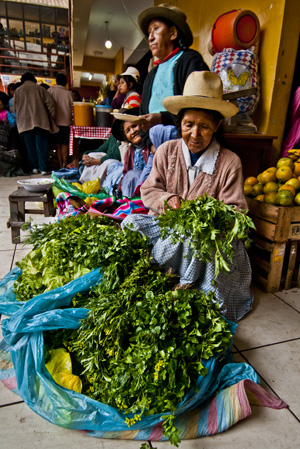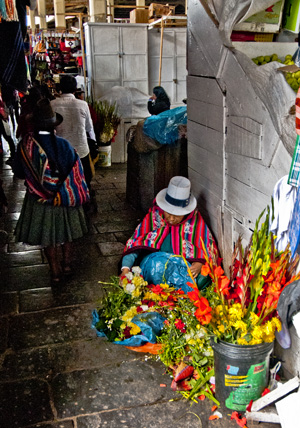Marketing: What I Learned From Peruvian Markets
Traveling in Peru, I visited many local markets, from the large mercados of Miraflores and Cusco, to tourist markets of Pisac, to the small village markets of Chivay and Ollantaytambo. I love the sights and smells and how they tell you a lot about the culture you are travelling in. But now that I’m home and starting to focus on the business of writing, I realized that there are marketing lessons for writers and indie publishers to be learned from the markets of Peru.
Before I list the five general lessons, I just want to comment on writers versus independent publishers. It used to be that independent publishers, were exactly that – small publishing houses as differentiated from the large houses of New York. Today, however, though the traditional independent publishers still exist (thank goodness), the self-publishing writer has a choice: they can either publish as authors, or they can create independent presses that publish their work. Either way, it’s the writer doing the work, but there are benefits to having a publishing house, that self-publishing as a writer doesn’t have – namely that an indie publishing house can get its books into bookstores more easily than a writer can.
The following five lessons apply to both independent publishing houses and writers publishing on their own.
1) Product must get to market – In Peru’s cities trucks unload crates of fruit and vegetables. In Chivay, the produce comes to town wrapped in colorful mantas (blankets) on women’s backs. They brought in everything from tomatoes, apples, and animal fodder. Sheep were tied upside down to the back of a moto-taxi on the way to market. So however, they did it, the bottom line was that items for sale had to get to market.

For the writer/indie publisher, this is perhaps the largest issue. Yes, writers have the traditional methods of getting manuscripts to traditional publishers, but now they have the choice of whether to publish into the electronic market or POD – both of which are now extremely acceptable ways of selling.
2) You must have a regular place to sell – In Peru I purchased my snack food – oranges, apples or bananas – at the local markets. When I can get them, died fruit and nuts are a staple. When I found a merchant that sold produce I liked, I always went back to them. Thankfully, mercado and street vendors have ‘their’ spots so you can always find the same apple vendor in the same spot.

For writers this means having a website – or two. At the very least you should have an author’s website (or possibly more than one if you are writing under more than one pseudonym) that includes in it a list of your books with links to where they can be purchased.
If you are serious about indie publishing, you should also have a website for your publishing house that includes all of your books (see examples, here and here and here), and presents all the books by all your writing personas. This allows people to find you and your books.

3) You must have product – The markets of Peru are filled with produce. There are fruit and vegetables, meat, breads and cakes, fresh cheese, nuts, dried fruit, jugos (fresh mixed juice that is the most sublime treat – ever), shaman supplies, clothing, tourist weavings and so on. Most markets provide a wonderful place for browsing.
For the writer, this means that although self-publishing a single short story or novel is fine, to be serious about indie publishing you must have more product. Dean Wesley Smith talks about having a minimum ten novels. What this means for the writer, is that the focus HAS to be on writing more product, so that you aren’t dependent on just selling oranges in a world where oranges might fall out of favor.
4) Product must look good – I couldn’t tell you how many vendors I walked past looking for the perfect orange or apple. Imagine how much time I spent in front of the kiosk where the vendor had avocados the size of green footballs. Good looking fruit is a lot more likely to sell than produce that looks like it’s had a hard ride on a bucking donkey.

For the writer this means that your produce needs to both look good and BE good – or at least as good as you can make it. As a writer you are responsible for the quality of your work both in terms of story and editing. Covers are the responsibility of the writer/indie publisher and are your calling card. Good covers, as Joe Konrath frequently talks abouton his blog (here), are critical to sales.
5) Product must be positioned – Peruvian vendors always took advantage of their location to show their wares. Some, near the doors, laid out attractive displays to catch the sunlight. Independent vendors crowded around the main doors to get attention. Others located themselves by side doors where they might not get as much traffic, but they might get more attention from those who DID pass through the doors.

As a self-publishing writer, or an indie publisher, you also need to make choices about how to get the attention of booksellers and readers. This can be either as simple or as complex as you want to make it. Examples of means to get attention for product include:
• Social marketing on twitter, facebook, etc.
• Social marketing on reader and writer groups
• Providing free fiction as loss leaders
• Advertising at conferences
• Advertising to booksellers
Choosing the methods that are right for you is the trick.
Given marketing is as foreign as a Peruvian market to me, I’ve planned a series of blogs that will explore marketing and provide information from authors who have gone farther down this road. So don’t consider me an expert, but look at this as a place to pull together ideas. Over the coming weeks I’ll explore each area in more depth and include interviews and examples. And please, if you have experiences in marketing as an author or indie publisher, share them here. After all, the last lesson I learned in Peruvian markets is that vendors help each other.










